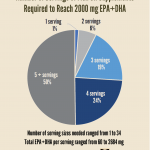Published on July 31, 2023

Have you taken advantage of the home blood spot test to measure your omega-3 status through GrassrootsHealth? Do you know what steps you want to take after receiving your results? Do you know if the steps you have been taking are working?
Measuring your omega-3 status using the Omega-3 Index can give you a clear picture of whether or not you are getting enough omega-3 fatty acids on a regular basis. Including the AA:EPA and Omega-6:Omega-3 ratios can help you determine if you are getting a good balance of anti-inflammatory and pro-inflammatory fatty acids, and whether decreasing the intake of omega-6 fatty acids may also be necessary for improving your health. Utilizing these tests together can also provide guidance to specific dietary changes that could support improvements in chronic inflammation and disease.
Most of our participants who measure their Omega-3 Index have a level below 8%, the minimum level recommended by omega-3 scientists for optimal health. This includes many who are already taking omega-3 supplements!
Testing AND re-testing are both important to make sure you are getting the omega-3 fatty acids your body needs from your diet and from the supplements you are investing in. The blogs featured below contain important information to help you decipher how to use your Omega-3 Index results to determine the best next steps to take if your level is too low – to get it up to that target range above 8%.
Tips for Improving Your Omega-3 Index and Choosing the Best Supplements for You
 How do you determine what dose of omega-3 supplements can help you reach your target? How much do you need, and how can you tell if you are getting enough omega-3s? Similar to vitamin D, there is a wide variation in how an individual’s Omega-3 Index responds to the amount of omega-3 fatty acids they consume (this will be discussed in more detail in an upcoming post). Below, we illustrate how much omega-3 fatty acids may be needed to reach a target level.
How do you determine what dose of omega-3 supplements can help you reach your target? How much do you need, and how can you tell if you are getting enough omega-3s? Similar to vitamin D, there is a wide variation in how an individual’s Omega-3 Index responds to the amount of omega-3 fatty acids they consume (this will be discussed in more detail in an upcoming post). Below, we illustrate how much omega-3 fatty acids may be needed to reach a target level.
What Dose of Omega-3s is Right for You?
 Use the omega-3 calculator to help you determine your intake needed to reach your target Omega-3 Index
Use the omega-3 calculator to help you determine your intake needed to reach your target Omega-3 Index
Use the Omega-3 Index Calculator Here
 Understand that most omega-3 supplements do not provide enough of what the majority of individuals need in order to achieve and maintain their target level. A recent study concluded that “Patients cannot rely on recommended serving sizes provided on natural product labeling to guide them to proper dosing of daily intake of fish oil to achieve health benefits.”
Understand that most omega-3 supplements do not provide enough of what the majority of individuals need in order to achieve and maintain their target level. A recent study concluded that “Patients cannot rely on recommended serving sizes provided on natural product labeling to guide them to proper dosing of daily intake of fish oil to achieve health benefits.”
Most Fish Oil Supplements do Not Provide Adequate EPA+DHA per Serving
 Before purchasing your supplements, make sure you know how to read omega-3 supplement labels so that you are getting the amount of DHA and EPA you are aiming for, or as suggested by the calculator. Formulations for these supplements vary widely in the amount of EPA and DHA as well as in the type of oil and form of omega-3 fatty acid.
Before purchasing your supplements, make sure you know how to read omega-3 supplement labels so that you are getting the amount of DHA and EPA you are aiming for, or as suggested by the calculator. Formulations for these supplements vary widely in the amount of EPA and DHA as well as in the type of oil and form of omega-3 fatty acid.
What information is important on Omega-3 supplement labels?
 Research is now showing evidence that both DHA and EPA have unique benefits to our health. Much of what you hear about the health effects of omega-3 fatty acids is as a whole combination of omega-3s versus the individual omega-3 fatty acids, such as EPA and DHA. However, some of the latest research has begun to focus on differentiating the effects of each, with evidence mounting on their unique benefits and their interactions with other nutrients. Decide if you prefer more of one or the other for your own health benefits.
Research is now showing evidence that both DHA and EPA have unique benefits to our health. Much of what you hear about the health effects of omega-3 fatty acids is as a whole combination of omega-3s versus the individual omega-3 fatty acids, such as EPA and DHA. However, some of the latest research has begun to focus on differentiating the effects of each, with evidence mounting on their unique benefits and their interactions with other nutrients. Decide if you prefer more of one or the other for your own health benefits.
DHA vs EPA – is there a difference in what to take and why?
 Is your Omega-3 Index not increasing with increased doses of fish oils? The type of fish oil supplement you are taking may be the culprit! Looking for the triglyceride form of fish oils is important for better absorption, however, many products formulated to have increased concentrations of EPA and/or DHA may actually be in the form of ethyl esters due to processing of the fish oils in the supplement. Learn what form of fish oil is best for absorption, and what to look for in your supplement.
Is your Omega-3 Index not increasing with increased doses of fish oils? The type of fish oil supplement you are taking may be the culprit! Looking for the triglyceride form of fish oils is important for better absorption, however, many products formulated to have increased concentrations of EPA and/or DHA may actually be in the form of ethyl esters due to processing of the fish oils in the supplement. Learn what form of fish oil is best for absorption, and what to look for in your supplement.
Why Your Omega-3 Supplement May Not be Increasing Your Omega-3 Levels as Expected
 Interested in other forms of omega-3 fatty acids, besides fish oil, such as krill or algal? A preliminary analysis indicates that algal oil may be more effective than fish oil, but less effective than krill oil at raising Omega-3 Index levels since the steepness of the dose-response line for algal oil users was in between fish oil users and krill oil users.
Interested in other forms of omega-3 fatty acids, besides fish oil, such as krill or algal? A preliminary analysis indicates that algal oil may be more effective than fish oil, but less effective than krill oil at raising Omega-3 Index levels since the steepness of the dose-response line for algal oil users was in between fish oil users and krill oil users.
 Can you achieve an Omega-3 Index of 8% through diet alone? Are supplements or food sources of omega-3s best for you to raise your levels?
Can you achieve an Omega-3 Index of 8% through diet alone? Are supplements or food sources of omega-3s best for you to raise your levels?
How does fatty fish intake affect Omega-3 Index?
Does all seafood provide the same amount of omega-3s?
Measure or Re-Measure Your Omega-3s with Vitamin D to Make Sure You are Getting Enough
 Having and maintaining healthy omega-3 and vitamin D levels can help improve your health now and for your future. Choose which additional nutrients to measure, such as your essential minerals including magnesium and zinc, by creating your custom home test kit today. Take steps to improve the status of each of these measurements to benefit your overall health. With measurement you can then determine how much is needed and steps to achieve your goals. You can also track your own intakes, symptoms and results to see what works best for YOU.
Having and maintaining healthy omega-3 and vitamin D levels can help improve your health now and for your future. Choose which additional nutrients to measure, such as your essential minerals including magnesium and zinc, by creating your custom home test kit today. Take steps to improve the status of each of these measurements to benefit your overall health. With measurement you can then determine how much is needed and steps to achieve your goals. You can also track your own intakes, symptoms and results to see what works best for YOU.
Enroll in D*action and Test Your Levels Today!




